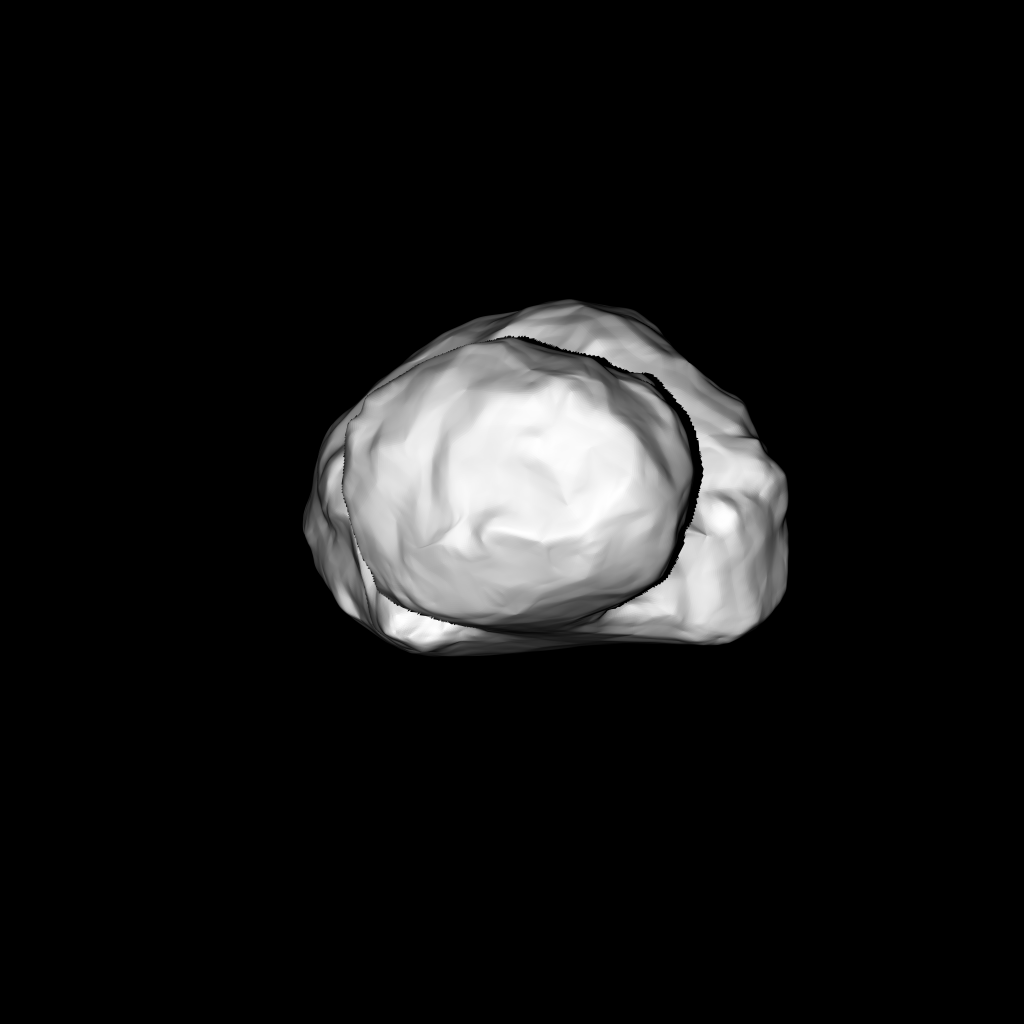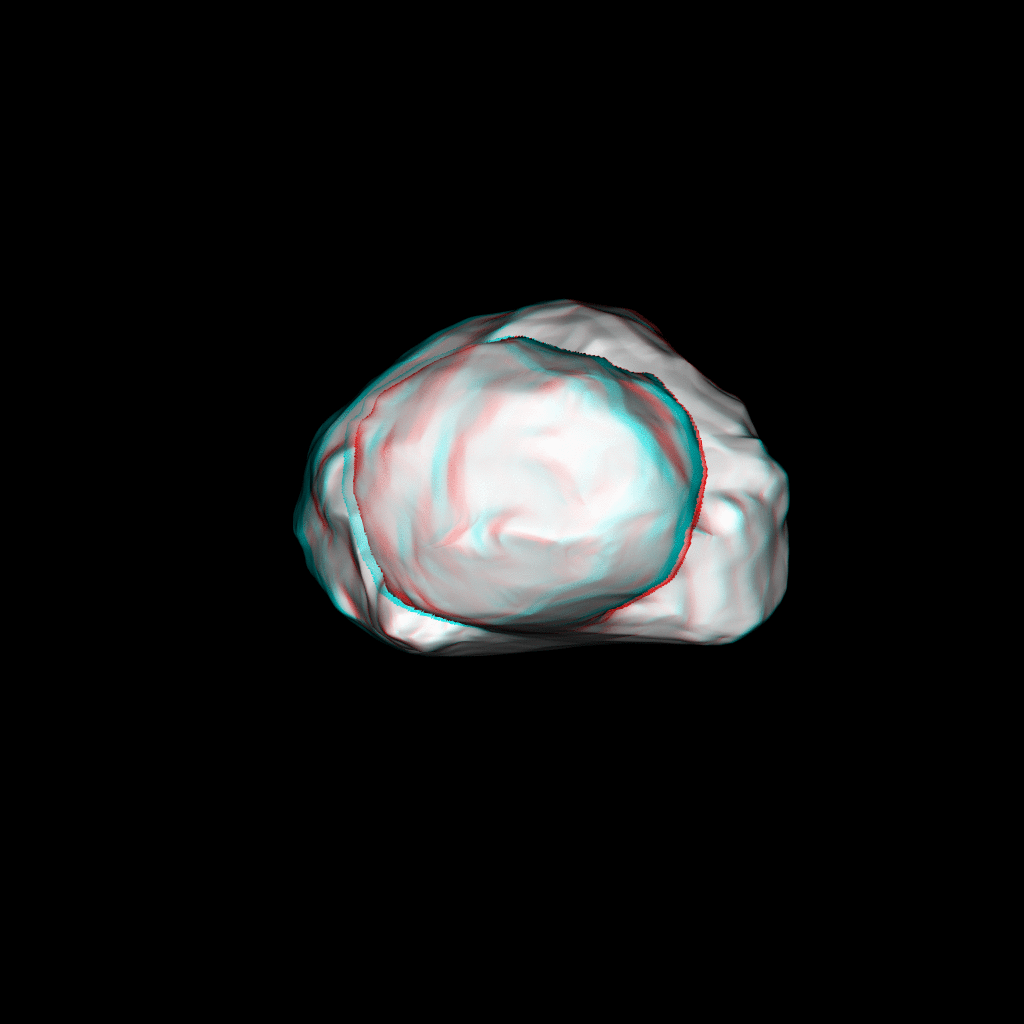Last week we shared a shape model of comet 67P/C-G based on the previous week’s images. Now the OSIRIS team have used images taken from 14-24 July to create a revised, more detailed model. This model is a formal product delivered to the Orbiter and Lander Teams to aid with their preparations for orbiting around and, eventually, landing Philae on the comet.
Grab a pair of red-green/blue glasses to enjoy the anaglyph version, too!

Comet 67P/C-G shape model based on OSIRIS images 14-24 July. Credits: ESA/Rosetta/MPS for OSIRIS Team MPS/UPD/LAM/IAA/SSO/INTA/UPM/DASP/IDA
The ultimate goal of the landing site selection process is to identify a safe and scientifically interesting site for Rosetta’s lander, Philae. A meaningful selection can only be made once the spacecraft is close enough to be able to characterise the comet surface and its environment, but preparations can start to advance now that the comet’s approximate shape and rotation properties are known.
Flight dynamics teams will need to plan the trajectories that are needed to safely navigate around the comet and to determine the best flight paths for delivering the lander to the surface.
But the landing site itself must also meet certain criteria. It must provide suitable illumination – an important factor for recharging the lander’s battery via on-board solar panels, and offer good visibility to the orbiter, as Philae relays information to Earth through mothership Rosetta. It must also be free from hazards such as large boulders or crevasses, features that can only be identified once Rosetta is much closer to the comet.
Next week, on 6 August, Rosetta arrives at the comet at a distance of about 100 km, moving down to about 50 km towards the end of the month. At the same time, five candidate landing sites will be selected for further detailed investigation.
Then, as Rosetta moves to a distance of just 30 km from the comet’s surface, more details of its surface will be revealed, allowing higher resolution imaging of the candidate sites. At an altitude of 30 km, the Narrow Angle Camera of OSIRIS will provide a surface resolution of 55 cm per pixel.
One primary landing site will be identified in mid-September, with a detailed analysis of possible flight paths then carried out, before a final decision is made to go ahead and prepare for landing, currently planned for 11 November.

Use red-green/blue ‘3D’ glasses to enjoy this version of the latest shape model.
Credits: ESA/Rosetta/MPS for OSIRIS Team MPS/UPD/LAM/IAA/SSO/INTA/UPM/DASP/IDA









Discussion: 29 comments
The language needs a new word! x is to moon as peninsula is to island. x=Penluna?
Good Idea!!!
What about lobe?
Wow, what amazing clarity! The team has done an outstanding job of extrapolating such precise topological information from such tiny images.
Might I be able to access the file for that model somewhere?
Awsome! 3D glasses ahoy!
Does this animation show the actual rotational axis of the comet?
The shape model is rotating to highlight better the distinct shape of the comet. Refer to https://www.esa.int/spaceinimages/Images/2014/07/Rotating_view_of_comet_on_14_July_2014 for how the comet is rotating from the viewpoint of Rosetta (as per Marshall’s comment, in fact).
The model is rotating about an arbitrary axis, not
the axis of rotation revealed by the DLR image movie. https://www.dlr.de/dlr/en/desktopdefault.aspx/tabid-10081/151_read-11055/#/gallery/15678
I would guess that this model was derived from higher resolution images than the publicly available NAVCAM images.
Yes – it was derived from recent OSIRIS images.
Actually, looking at the 2 movies longer, the model might be rotating about an axis close to the revealed rotation axis. It is hard to tell given the considerably different perspective.
The postlast week on the 1st version of the 3D model states that the rotation axis used for display is the real axis, and this looks to be the same. I think Roseta is approaching from a bit North of the comet’s equator, so there will be a region near the South pole that it can’t see any gap on the model. Or is the flat-looking South pole region on the model the data gap?
Yes, Rosetta is approaching the ‘northern hemisphere’ of the comet, what ever passes as a hemisphere of such an irregularly shaped body 😀
Rosetta will get to see the ‘southern hemisphere’ later on in the mission when Comet 67P/ C-G has moved further around the sun.
Actually, Rosetta will fully map the comet in the coming weeks, this should be complete by the beginning of October.
It is a prerequisite for the landing site selection ! And not only optical, all instruments will be active during this process.
Is there already a (crude) coordinate system in use for the nucleus? Would be helpful to know for the public at large when talking about specific features now that we are beyond that “look, a rubber ducky” stage …
Since features have yet to be well-defined, I understand this is currently a work in progress.
Looks like it was once two separate rocks that have conjoined. Might mean that there’s a chance that there will be two different electromagnetic frequencies emitted from this baby when friction starts from the sun’s energy.
One part of the comet looks much larger and flatter. Would it be best to aim Philae for the middle of this?Could a coordinate system be placed, or temporary names given?
How much mass will the comet lose with its current rondez-vous with the sun, percentage wise?
Would you please publish this model for all the 3D-printer-users as a STL/OBJ/STEP/IGES-File?
yes please
Thanks a lot for the new diagrams!
Having in mind suitable landing sites for Phillae,
it might also make sense to collect temperature
profiles. Of course, illumination is important
for the solar panels of P. But warmer/hotter
sites may also carry higher risks of local
cometary outbursts – being a danger for P.
Ingo.
Is there information somewhere on the orientation of 67P’s rotation axis with respect to its orbit? At closest approach to the Sun, are there parts of the comet that remain in shadow – polar winter? Or is perihelion nearer to equinox?
Thanks
I’m blown away by this mission. Congratulations to all involved. It’s probably made of dusty ice balls joined together. I would be surprised if it turns out to be a rubber ducky… Cheers.
Where have the dust- / gas emissions gone ?
Is 67P tidying up for the visit ?
It would be interesting to slowly heat/melt a spinning ice block on the ISS and see if it separates in this sort of fashion.
In the “red-green/blue ‘3D’ glasses” picture the channels needs a swap! Normaly red is left while in this picture blue is left.
Anyway thank you for sharing..
Toi, toi, toi, Mark.
Good and NOT so good idea, I assume. Ths ISS uses 90 minutes around the Earth 16 times per day, but only about 60 minutes would be available for the sun-light to influence om the fixed or rotating snow/ice block. But the released particles would endanger the ISS on its next revolution when it returns to the same area and hit the stations construdtion in a dangerous speed and harm lenses, walls and other equipment on the outside of the staition. lso some of the particles will losse they speed and “fall” down to the athmosphere after a while. Also they releases student built satellites of the 10x10x10 sizes.
Looks like by conception these where originally two blobs of matter that froze solid before they could fully separate.
Where can people download the model to 3D print their own comet? A .STL, .OBJ or .3DS file format would be preferred, but any kind of points file would be fine.